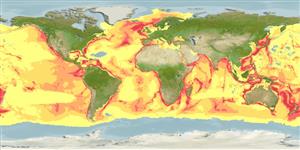Common names from other countries
Environment: milieu / climate zone / depth range / distribution range
Ecologie
Pelagisch; oceanodroom (Ref. 75906); brakwater; diepteverspreiding 0 - 3510 m (Ref. 116169). Tropical; 13°C - 28°C (Ref. 75906); 90°N - 90°S, 180°W - 180°E
Atlantic, the Mediterranean, Indo-Pacific and the Antarctic. Tropical to temperate.
Length at first maturity / Size / Gewicht / Leeftijd
Maturity: Lm ? range ? - ? cm Max length : 380 cm TL mannelijk/geslacht niet bekend; (Ref. 1394); Maximaal gepubliceerd gewicht: 500.0 kg (Ref. 1394)
Inhabits deep oceanic and continental slope waters of the tropics through the temperate regions in both hemispheres. Feeds os (Ref. 1394). Feeds in deeper waters (Ref. 122680) on crustaceans and cephalopods, but prefers squid (Ref. 1394).
Breeding is year-round.
Tan, J.M.L. 1995. (Ref. 936)
Status op de Rode Lijst van het IUCN (Ref. 130435)
Status bij CITES (Ref. 108899)
Gebruik door de mens
Visserij: commercieel
FAO - Visserij: landings, soortsprofiel | FishSource | Sea Around Us
Tools
Internet-bronnen
Estimates based on models
Preferred temperature
(Ref.
115969): 4.2 - 15.7, mean 8.7 (based on 2801 cells).
Weerstandsvermogen
Hoog, minimale populatieverdubbelingstijd minder dan 15 maanden (K=0.49-0.57; tm=11).
Kwetsbaarheid
Moderate vulnerability (41 of 100).
Prijsklasse
Unknown.
